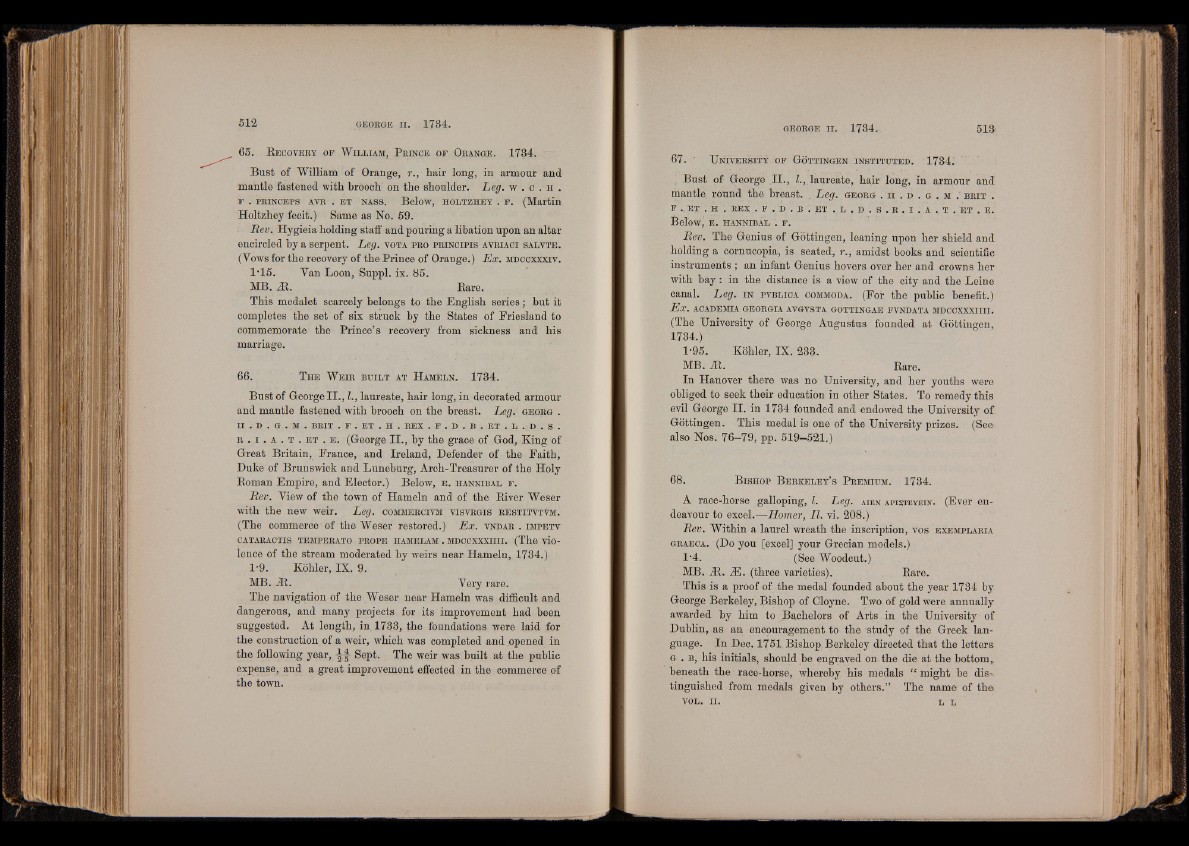
65. R ec o v er y o f W il l ia m , P r in c e o f Or a n g e . 1734.
Bust of William of Orange, r., hair long, in armour and
mantle fastened with brooch on the shoulder. Leg. w . c . h .
F . PRINCEPS AVR . ET NASS. Below, HOLTZHEY . F . (Martin
Holtzhey fecit.) Same as No. 59.
Rev. Hygieia holding staff and pouring a libation upon an altar
encircled by a serpent. Leg. vota pr o p r in c ip is a v r ia c i sa l v t e .
(Vows for the recovery of the Prince of Orange.) Ex. mdccxxxiv.
1*15. Van Loon, Suppl. ix. 85.
MB. At. Rare.
This medalet scarcely belongs to the English series; but it
completes the set of six struck by the States of Eriesland to
commemorate the Prince’s recovery from sickness and his
marriage.
66. T h e W e i r b u il t a t H am e l n . 1734.
Bust of George II., I., laureate, hair long, in decorated armour
and mantle fastened with brooch on the breast. Leg. g eo r g .
I I . D . G . M . BRIT . F . ET . H . REX . F . D . B . E T . L . D . S .
r . i . a . t . e t . e . (George II., by the grace of God, King of
Great Britain, France, and Ireland, Defender of the Faith,
Duke of Brunswick and Luneburg, Arch-Treasurer of the Holy
Roman Empire, and Elector.) Below, e . h a n n ib a l f .
Rev. View of the town of Hameln and of the River Weser
with the new weir. Leg. commercivm v isv r g is r e s t it v t Tm .
(The commerce of the Weser restored.) Ex. vndar . im p e t v
CATARACTIS TEMPERATO PROPE HAMELAM . MDCCXXXIIII. (The violence
of the stream moderated by weirs near Hameln, 1734.)
1-9. Kohler, IX. 9.
MB. At. Very rare.
The navigation of the Weser near Hameln was difficult and
dangerous, and many projects for its improvement had been
suggested. At length, in 1733, the foundations were laid for
the construction of a weir, which W’as completed and opened in
the following year, Sept. The weir was built at the public
expense, and a great improvement effected in the commerce of
the town.
67. ' U n iv e r s it y o f G ö t t in g e n in s t it u t e d . 17841
, Bust of George II., Z., laureate, hair long, in armour and
rnantle round the breast. Leg. g eo r g . i i . d . g . m . b r it .
F .„ E5C . H . REX... F . D . B . ET . L . D . S . R . I . A . T , ET , E .
Below',' E . HANNIBAL . F.
Rev. The Genius of Gottingen, leaning upon her shield and
holding a cornucopia, is seated, r., amidst books and scientific
instruments ; an infant Genius hovers over her and crowns her
with bay : in the distance is a view of the city and the Leine
canal. Leg. in pv b l ic a commoda. (For the public benefit.)
Ex. ACADEMIA GEORGIA AVGVSTA GOTTINGAE FVNDATA MDCCXXXIIII.
(The University of George Augustus founded at Göttingen,
1734.)
1-95. Köhler, IX. 233.
MB. At. Rare.
In Hanover there was no University, and her youths were
obliged to seek their education in other States. To remedy this
evil George II. in 1734 founded and endowed the University of
Göttingen. This medal is one of the University prizes. (See
also Nos. 76-79, pp. 519—521.)
68. B is h o p B e r k e l e y ’s P r em iu m . 1734.
A race-horse galloping, Z. Leg. a i e n a p i s t e y e i n . (Ever endeavour
to excel.—Homer, II. vi. 208.)
Rev. Within a laurel wreath the inscription, vos ex em p l a r ia
gr a e c a . (Do you [excel] your Grecian models.)
1'4. (See Woodcut.)
MB. At. 2E. (three varieties). Rare.
This is a proof of the medal founded about the year 1734 by
George Berkeley, Bishop of Cloyne. Two of gold were annually
awarded by him to Bachelors of Arts in the University of
Dublin, as an encouragement to the study of the Greek language.
In Dec. 1751 Bishop Berkeley directed that the letters
g . b , his initials, should be engraved on the die at the bottom,
beneath the race-horse, whereby his medals “ might be distinguished
from medals given by others.” The name of the